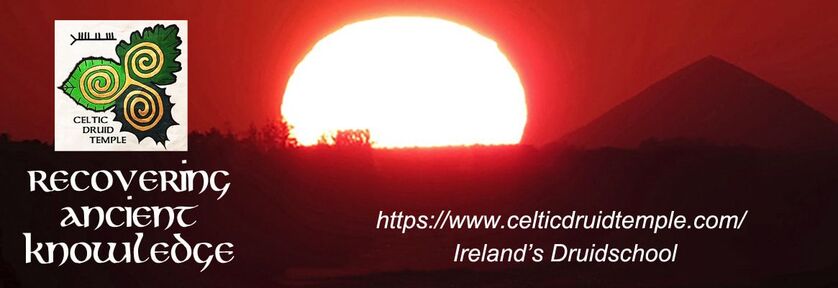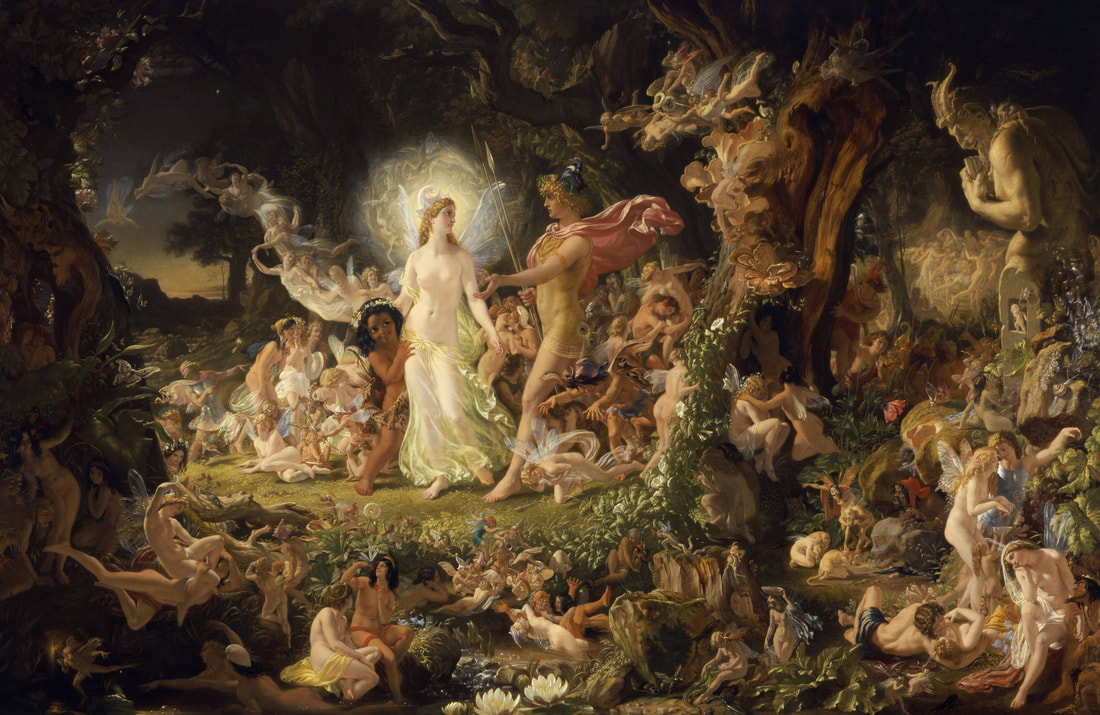Who are the fairies?
Fairies are otherworldly creatures that inhabit an world invisible to humans[Dái06]. Most European nations have their own fairy tradition with each having their own unique origins stories. Fairies first appeared in Ireland in the early 12th century[Nor20] and seem to be heavily intertwined with the lore of the dead, some of the first tales of fairies evolve from the belief of the dead living on in their burial chamber[Dái06]. This might explain the use of the word sí to describe both fairies and the mythical other world. The Ancient Irish believed that fairies were the first settlers of Ireland. These people were known as the Tuatha de Danaan. The De Danaan conquered all of Eire until they were defeated by the Milesians. The Milesians were believed to be the ancestors of the modern Irish people. Not willing to cooperate with their conquerors, the De Danaan went into hiding and lived in the hills leading to them gaining a new name, Aes Síde or Sí which in this context means mound[Nor20]. The Tuatha De Danaan were often depicted as living in raths, mounds and lakes in the tales of Fionn Mac Cumhaill and in the Book of Invasions. The Tuatha De Danaan or fairy people were described as being the same height as normal people and dressed in elegant green clothing. They had many different abilities such as turning invisible and changing their appearance. The fairies were seen as godly to mortal people, hence, there lifestyle were often associated with the interests of the time. Interests such as music, war and chase were the occupation of the fairies. Their musical abilities were revered, and some of the best musicians of the time credited their best works to the fairies[Nor20]. The other origin tale was the Christian perspective on fairies, the existence of a Christian origin story for the fairies displays the strength of the belief. According to the church, fairies are angels who were thrown out of heaven by God. The tale depicts God opening the floor of heaven and casting Satan and other angels out, when he closed the floor, the angels that had fallen with Satan became his servants, Angels that had landed on the surface become land fairies, the fairies that landed in the sea became sea fairies while the fairies in the air become the air fairies. These exiled angels spend their time trying to get back into heaven by stealing children blood. The fairies are known by many names as there was a folk assumption that you should not refer to the fairies by their name[Joh00]. The fairies are also known as “the good folk” or “the noble folk”
Fairies in Modern Belief
In contrast to the early accounts of fairies in Ireland, the fairies of the 19th and 20th century had a much more volatile relationship with their human counterparts. The fairies were still associated with a lot of good in Ireland, such as music. In the documentary, “The Fairy Faith” a family of musicians recounts how their grandfather came to the acclaim to the people for his musical skills. The grandfather attributes his talents to the fairies, claiming that he played music for a fairy wedding and met two famous fiddlers who thought him the skills he had now[Joh00]. However, the fairies were feared by the people of Ireland and were normally the ones blamed for bad things happening, people were afraid to interfere with fairies on superstitious nights such Halloween, or Hallow Eve. An interesting element of fairy tradition that became popular was changelings. Changelings are fairies that resemble the human that they replace. It was believed by the rural Irish that a changeling was odd and wise beyond their years. The changeling would eventually disappear, if the changeling was discovered during the time it was alive, it would bring back the person it replaced. The presence of changelings were quite common, however, I haven’t encountered a tale where the subject has the person that was taken from them return. One particular tale that was quite disturbing was the burning of Bridget Cleary in 1895. Bridget Cleary was recently wedded to her husband Michael Cleary in County Tipperary. They had lived a happy marriage until her husband noticed his wife acting strangely. The exact details of how his wife was acting strange isn’t told, however it does say that he first suspected his wife being a changeling when she took sick for a few days from a cold. An old man visited the house and told him that the woman in the bed wasn’t his wife. When she didn’t get better, Mr. Cleary became convinced that the woman he was married to was a changeling. He sought a fairy doctor who gave him a cure for expelling the changeling. That night a large number of the Cleary family gathered to witness the expelling of the changeling. When Mrs Cleary refused to take the cure, she was forced to do by a hot poker. She was constantly question and shook as the family attempted to get rid of the changeling. Eventually they placed her over the stove and continued to ask her questions. Eventually the occupants of the house were sasified that Mrs Cleary was not a fairy. Michael Cleary remained unconvinced and the next day when his wife refused to eat he threw her into the fire and poured lamp oil on her. His house went on fire and with it went the supposed changeling. Weeks pasted and his wife did not return which led to Cleary growing remorseful. The occupants of the house were eventually charged with man slaughter[Tho82].
Fairies in Meath
The Schools collection of Co. Meath suggest that fairy belief was quite weak, there is few stories referring to fairies. The three accounts I have included with this essay are entitled Fairies Football, Fairy Reel and Fairy Fort, I chose these particular tales because they were the most common themes of fairy stories in Meath. Fairy football is a about a boy called Seamus who was sitting on Piercetown Hill. He heard shouting and looked down to see a fairy football match taking place. He was impressed by one of the players who wore a red cap and at the end of the game, he shouted out “well done red cap”, when he spoke he was surrounded by a troop of fairy soldiers and was imprisoned and never seen again. Fairy Reel was about fairies unique musical talents, two girls were walking home when they saw dancing fairies in a field, they were struck by the wonderful music of the fairies’ and rush home to tell their mother what they saw. The tale continues with the farmer who owned the field believing that the fairies had a pot of gold buried in his field, he ploughed the field but the grass grew back in a day and he “left the good people to their spring dance”. Unsurprising, fairy places were quite a prominent subject, Meath has many famous burial chambers and scared sites such as Tara and Newgrange which were the preferred dwellings of the fairies. The story I chose described a fairy fort called Rath Maeve near the Hill of Tara, It claims that a fairy with an apron took all the clay from a hill and made the mound with it. The tale also says that if you were to walk under Rath Maeve you would end up on the Hill of Skryne. Modern fairy stories are quite prominent in Meath, from my personal experience there is still a silent belief in fairies in Meath. On the Hill of Tara there is a hawthorn tree known as the fairy tree. I regular walk past this tree on my visits to Tara and it is often covered in ribbons, gifts and sometimes wishes to the fairies. After the construction of the M3 motorway, activist Carmel Divine claimed that the construction of the M3 motorway through the Tara-Skyrne valley angered the fairies and that the woes of Ireland since July 2007 was the fairies taking revenge[Gui11].
Interviews
My interviews were quite successful and I uncovered some interesting perspectives on fairy lore in Meath. My objective with the interviews was to get a contrast between old and modern fairy tradition to see if it had changed since The Schools Collection was taken. My first interviewee told me about some tales of people who have interfered with fairies and were punished such as a man who bulldozed a fairy fort in Oristown County Meath. He was beheaded by a broken saw blade soon after. My second interviewee provided a lot of information I had never encountered before. He described fairies as energy forms that can take on humanoid forms if they wish to. My interviewee had seen fairies before and he said that they would appear only in your peripheral vision. They would usually be about 40-50 yards away. He told me that fairies were misunderstood creatures and were often blamed for bad things such as storms, rain and deaths or behaviour changes caused by illness. He also talked about different fairy types such as the banshee, which was a fairy that sings before someone dies. Both interviewees agreed that fairies were neither good nor bad, they were like us.
Conclusion
Fairy tradition in Meath is quite odd, I found it quite difficult to find tales of fairies in the Schools collection despite the presence of the Hill of Tara in a lot of the children accounts. In my interviews, one of my interviewees said there was a stigma in the belief of fairies and I suspect that this stigma might already have begun in the 1930s in Meath. There is a wealth of tradition and lore about the Battle of the Boyne, local cures and weather lores in Meath. The Battle of the Boyne is a clear source of pride among the children with a lot of descriptions and followed on stories in their accounts. Fairies do not receive the same treatment, the stories about fairies are isolated and often seem outplace with the other traditions that the children associate with their local town. I believe this might the setting in of the stigma about fairies in Meath and the stories that do remain are the ones that the past generations had told their kids. This provides quite a contrast with modern fairy tradition with that of the past. As I mentioned above, there are many stories and mentions of the fairies in modern Meath folklore, especially the fairies of Tara. Both my interviewees told me that there is a select group of people who believe in fairies and many live in Meath which I find interesting as this belief appears to revival of an old tradition. However the stigma still exists and becomes an interesting topic in itself when we consider whether a stigma is healthy for the tradition or killing the tradition. On one side, you could claim that a stigma on believing in fairies is leading to people being too afraid to speak about their fairy stories. However, if the stigma was non-existent would Irish fairy tradition become commercialised like the depictions we see today. It seems that the only thing certain about fairy tradition is that it isn’t going anywhere anytime quickly.
Bibliography
Guidera, A., 2011. Fairytale of New Ireland. [Online]
Available at: http://www.independent.ie/lifestyle/fairytale-of-new-ireland-26796272.html
[Accessed 7th April 2017].
hÓgáin, D. Ó., 2006. The Lore of Ireland. Cork : Collins Press.
McGrath, T., 1982. Fairy Faith and Changelings: The Burning of Bridget Cleary in 1895. Studies: An Irish Quarterly Review, 71(282), pp. 178-184.
O'Connor, N. J., 1920. The Early Irish Fairies and Fairyland. Sewanee Review , 28(4), pp. 545-557.
Súilleabháin, S., 1942. Handbook of Irish Folklore. s.l.:Folklore of Ireland Society.
The Fairy Faith. 2000. [Film] Directed by John Walker. s.l.: s.n.


 RSS Feed
RSS Feed